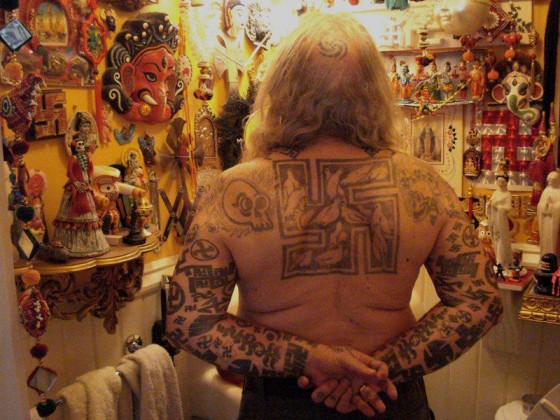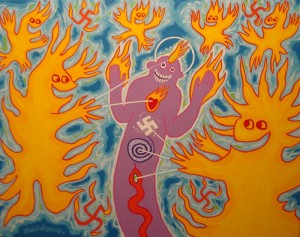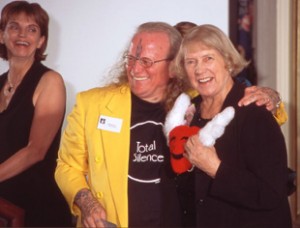ART: ManWoman sticks to sacred vision 48 years after drugless trips
 If you’re going to embark on a quest to reclaim the swastika as a sacred symbol of peace that’s been used by many different cultures for thousands of years until Hitler came along and ruined it for everybody, it’s hard to change your mind when you’re covered in swastika tattoos.
If you’re going to embark on a quest to reclaim the swastika as a sacred symbol of peace that’s been used by many different cultures for thousands of years until Hitler came along and ruined it for everybody, it’s hard to change your mind when you’re covered in swastika tattoos.
Edmontonian artist ManWoman has 200 of them on his body – which is especially mind blowing when you consider his Jewish background. His mother’s sister and niece were captured by the Nazis in Europe and sent to Auschwitz, had numbers tattooed on their arms, but were rescued just in time when their father “used every penny he had” to bribe the guards to let them go. The whole lucky family wound up in Canada.
“When I got my first swastika tattoo, my mother said it struck her right in the heart,” ManWoman says. “She was none too pleased. It took her a while to get used to it. So I had all this baggage, but my dreams were powerful enough: This beautiful old wise man with white hair and robes came up to me and marked my throat with a white swastika and said I needed to speak up about this symbol. The meaning is scared. It’s about God and love and the course of life and the sun.”
He knows what you’re going to ask, so get it out of the way: No, he never did LSD.
 Now a granddad living in Cranbrook, B.C., ManWoman – aka Manny Jack Lightning – is opening an art show this Sunday from 2-7 p.m. at Brittany’s Lounge (10225, 97 Street), with entertainment from the comparably wild Tippy Agogo, poetry readings from the artist and 30 new ManWoman pieces that have never been seen in Edmonton before. We should expect the same sort of colourful, psychedelic imagery in what could best be described as “pop art” – “Warhol on acid” may also suffice – in the same vivid style ManWoman has been creating almost continuously for 50 years. Almost all of his work is inspired by a single series of profound mystical trips he took at the dawn of the hippie era – no drugs required.
Now a granddad living in Cranbrook, B.C., ManWoman – aka Manny Jack Lightning – is opening an art show this Sunday from 2-7 p.m. at Brittany’s Lounge (10225, 97 Street), with entertainment from the comparably wild Tippy Agogo, poetry readings from the artist and 30 new ManWoman pieces that have never been seen in Edmonton before. We should expect the same sort of colourful, psychedelic imagery in what could best be described as “pop art” – “Warhol on acid” may also suffice – in the same vivid style ManWoman has been creating almost continuously for 50 years. Almost all of his work is inspired by a single series of profound mystical trips he took at the dawn of the hippie era – no drugs required.
“Everyone thought it was the most stoned person in Edmonton,” ManWoman recalls. “I spent from 1964 to 1975 in Edmonton, all my kids were born there and I probably went through my most formative years here. These spontaneous mystical experiences came out of the void, and it was amazing. I think I was quite an influence on the hippie scene in Edmonton. There was the Hovel, the Latitude 53 gallery and the Commune out at Onoway. The majority of the young people I knew were doing some sort of drugs and I just made a commitment to stick with my visions – because I didn’t want to ruin them.”
Besides, he adds, Edmonton didn’t even see any marijuana until 1967, at least not in his circle.
Not fully understood at the time was the phenomenon of frontal lobe seizures causing vivid hallucinations and various “God-like” experiences (here’s one of many articles on the issue) – so seeing a doctor didn’t even occur to ManWoman. What caused his visions wasn’t as important as what he calls the “divine” content of the messages therein. The trances, which started on Feb. 5, 1965 in a hotel room in Rocky Mountain House (he remembers the circumstances perfectly) went on for about a year before stopping of their own accord, and recurring again briefly for six months in 1981. He says he received powerful messages about peace and love and the meaning of God (and about the name he would give himself) – which not only was contrary to what all adults ever told him a child, he says, but dovetailed neatly with the spirit of the time. This was the ‘60s.
As an art teacher with a young family, “My wife was quite concerned how I was going to keep my job and feed the kids when I was going into a trance every two days,” he says. “Nobody talked about Kundalini and energy of the spine and all that. But my heart chakra would open up and I’d be flooded with love. The next time it was my third eye opening.”
ManWoman has a tattoo of his third eye on his forehead.
In his next trance, he remembers vividly, “My soul went home for the first time – it scared the hell out of me because I thought I was dying. And then I came back with the feeling of the scared is inside every one of us and all the nonsense that’s peddled in the name of religion and all of that stuff is all made up stories. It’s a bunch of BS.”
 He allows that the alternative “hoogie woogie” beliefs, crystals and whatnot, contains a healthy share of BS as well – and “I knew a lot of people running around with their crystals,” he says with a laugh. All he knows, he adds, is his own experience “that these centres awoke in me – and I had amazing experiences of what can only be called holiness and sacredness and love.”
He allows that the alternative “hoogie woogie” beliefs, crystals and whatnot, contains a healthy share of BS as well – and “I knew a lot of people running around with their crystals,” he says with a laugh. All he knows, he adds, is his own experience “that these centres awoke in me – and I had amazing experiences of what can only be called holiness and sacredness and love.”
ManWoman has published a book on his mission to save the swastika (Gentle Swastika: Reclaiming the Innocence), and has become something of a celebrity in the tattoo community, not to mention the Canadian art world. His style is distinctive. It’s rare to find an artist who sticks this closely to a single mission and message. He calls it “The Secret Doctrine of the Holy Fuck,” but strongly discourages anyone from thinking of it as any kind of new religion.
“I don’t want to be a cult leader,” he says. “I don’t want to start a new religion. We’ve got too many religions. I believe that everyone is spiritual. Every one of us has grace in our hearts and if we can just hook up with it, whatever it takes … (he tells a tale of guy he knows who was hit by lightning and became more spiritual; another who did so much acid he wound up in a mental ward, but got out and also emerged more enlightened) … Whatever it is takes to wake a person up, we’re in a living sacred phenomenon here. We call it life. There’s no disconnect. There’s never been a disconnect. People say, ‘I want to find God.’ Well, you know it. We have never been disconnected from what we call God, any of us. One of my jobs is to clear that up.”
ManWoman died of cancer in November, 2012.













